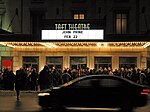Lytle Park Historic District
Abraham Lincoln in artGeorgian architecture in OhioHistoric districts in CincinnatiHistoric districts on the National Register of Historic Places in OhioIncomplete lists from April 2014 ... and 5 more
Italianate architecture in OhioNRHP infobox with nocatNational Register of Historic Places in Hamilton County, OhioParks in CincinnatiUrban public parks

Lytle Park Historic District is a historic district in Cincinnati, Ohio, United States. Roughly bounded by 3rd, 5th, Sycamore, Commercial Sq., and Butler Sts. in downtown Cincinnati, it centers on Lytle Park. In 2014, Western & Southern Financial Group, owner of many properties within the Lytle Park Historic District asked the city to remove historic status of several historic buildings. The company hopes to demolish sections of the district in order to build new office space.
Excerpt from the Wikipedia article Lytle Park Historic District (License: CC BY-SA 3.0, Authors, Images).Lytle Park Historic District
East 4th Street, Cincinnati Central Business District
Geographical coordinates (GPS) Address Nearby Places Show on map
Geographical coordinates (GPS)
| Latitude | Longitude |
|---|---|
| N 39.101111111111 ° | E -84.505277777778 ° |
Address
Literary Club of Cincinnati
East 4th Street
45202 Cincinnati, Central Business District
Ohio, United States
Open on Google Maps








